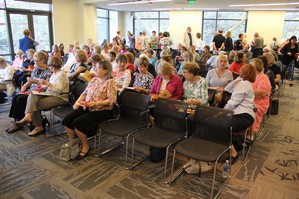Three bestselling California authors revealed the secrets behind successful mystery writing at the Project Second Chance (PSC) “Evening of Mystery” event at the Walnut Creek library October 9.
A panel of Cara Black, Laurie R. King, and Terry Shames compared notes on their books and their craft and responded to questions from the audience of the sold-out event to benefit PSC.
“A writer needs to hide the villain – he has to be smarter and better-looking” to establish the mystery, Black noted.
From King’s perspective, the villain thinks he’s the hero, while Shames said “The villains are ordinary people who’ve been pushed to the edge,” and she feels compassion for them.
The three authors use setting as a component of their novels, and each has a strong affinity for the locales of their mysteries.
A Francophile since she was in high school, Black has set all of her 14 private investigator Aimee Leduc novels in various Paris neighborhoods, including Murder in Montmartre, and Murder in Pigalle. “Paris is an exacting muse; I have to get her right,” she noted. She chatted with familiarity of the unique characteristics of the arrondissements she has visited, and the delights of frequent trips to Paris.
“Where my books are set, “pain au chocolat” would be “pain of chocolate,” Shames laughed, referring to Black’s affection for the French dessert.
Based on the small Texas town where her grandparents lived, Shames’ retired lawman Samuel Craddock series reflects her affection for “small towns where somebody is always getting up to something.” Her most recent in the series, A Killing at Cotton Hill, was nominated for a Macavity Award for best first novel.
King’s best-known series stars Mary Russell and Sherlock Holmes, partners in work and life, who travel the globe solving crimes. The twentieth anniversary edition of The Beekeepers’ Apprentice, first in the series, was released this year. Her Inspector Kate Martinelli series is set in San Francisco, and her next work takes place in a town based on Watsonville. “It’s fascinating to write about a place you know, where you shop and where the kids went to school,” she observed.
All had advice for writers and agreed that they would tell an aspiring author to “reach down inside yourself and write the book only you can write” as Shames said. To be a writer you don’t start with a book, King warned; she had completed three when her first was published in 1993.
Traditional publishing got the nod from all three.
“The machinery of the publishing world” is vital, King feels. “I am not an editor.” Black recalled her long-time editor as a woman who “literally rolled up her sleeves and got out her red pencil” and was instrumental to Black’s success. Shames said that gaining the acceptance and support of a well-known publisher fulfilled her dreams.
“Propping the notebook up on the steering wheel” while waiting for their kids at sports practice and music lessons was how Black and King found time to develop their craft when they began their careers, and all have an established routine. “But I got more done before social media came along,”
Black laughed.

